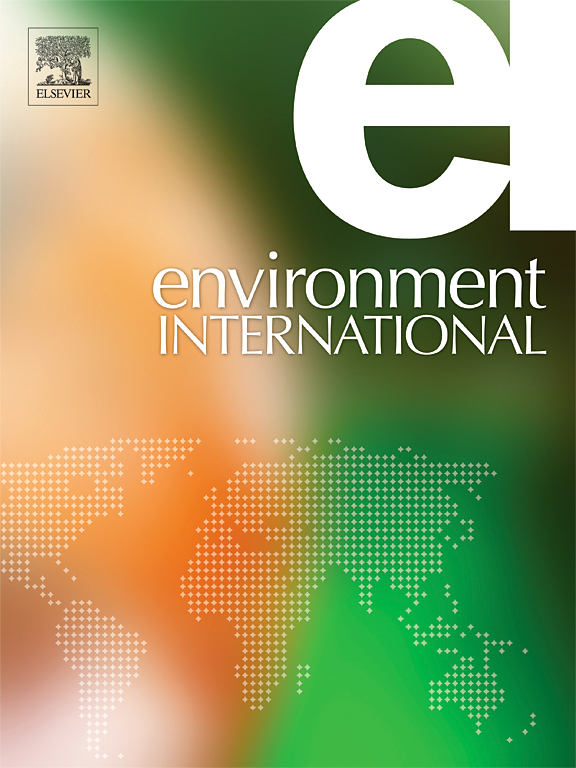波士顿出生队列中的脐带血浆代谢组学特征与产前接触全氟和多氟烷基物质(PFAS)的关系
IF 10.3
1区 环境科学与生态学
Q1 ENVIRONMENTAL SCIENCES
引用次数: 0
摘要
背景产前全氟和多氟烷基物质(PFAS)暴露与不良的后代健康结果有关,但其潜在的病理机制尚不清楚。脐带血代谢组学可以确定与产前PFAS暴露相关的潜在重要通路,提供有助于解释长期健康影响的机理见解。我们测量了产后 24-72 小时采集的母体血浆样本中的 PFAS 和脐带血浆样本中的代谢物。我们使用全代谢组关联研究和通路富集分析来确定与单个 PFAS 相关的代谢物和通路,并使用基于量纲的 g 计算来检验代谢物与 PFAS 混合物的关联。结果我们发现,有 331 种代谢物和 18 条通路与 ≥ 1 种 PFAS 相关,38 种代谢物与 PFAS 混合物相关,主要是氨基酸和脂类。氨基酸(如丙氨酸和赖氨酸)及其途径对能量生成、生物合成和骨骼健康至关重要,它们与全氟辛烷磺酸有关,这可能解释了全氟辛烷磺酸对胎儿生长限制的影响。肉碱和肉碱穿梭途径与 7 种全氟辛烷磺酸和全氟辛烷磺酸混合物有关,它们参与线粒体脂肪酸的β-氧化,可能导致胎儿和儿童生长受限和心血管疾病的风险增加。脂类,如甘油磷脂及其相关途径,可通过调节细胞膜上的转运体、参与β细胞信号传导途径和诱导氧化损伤,导致胰岛素抵抗和糖尿病。与全氟辛烷磺酸有关的神经传递相关代谢物和途径,包括辅助因子、前体和神经递质,可能是全氟辛烷磺酸影响儿童神经发育的原因。我们观察到,男性产前暴露于全氟辛烷磺酸与代谢物之间的关联性更强。结论这项前瞻性出生队列研究为有关产前暴露于全氟辛烷磺酸可能导致代谢紊乱的有限文献做出了贡献。需要进行更多的研究,以复制我们的发现,并将产前与全氟辛烷磺酸相关的代谢紊乱与儿童的长期健康结果联系起来。本文章由计算机程序翻译,如有差异,请以英文原文为准。
Cord plasma metabolomic signatures of prenatal per- and polyfluoroalkyl substance (PFAS) exposures in the Boston Birth Cohort
Background
Prenatal per- and polyfluoroalkyl substance (PFAS) exposures are associated with adverse offspring health outcomes, yet the underlying pathological mechanisms are unclear. Cord blood metabolomics can identify potentially important pathways associated with prenatal PFAS exposures, providing mechanistic insights that may help explain PFAS' long-term health effects.
Methods
The study included 590 mother-infant dyads from the Boston Birth Cohort. We measured PFAS in maternal plasma samples collected 24–72 h after delivery and metabolites in cord plasma samples. We used metabolome-wide association studies and pathway enrichment analyses to identify metabolites and pathways associated with individual PFAS, and quantile-based g-computation models to examine associations of metabolites with the PFAS mixture. We used False Discovery Rate to account for multiple comparisons.
Results
We found that 331 metabolites and 18 pathways were associated with ≥ 1 PFAS, and 38 metabolites were associated with the PFAS mixture, predominantly amino acids and lipids. Amino acids such as alanine and lysine and their pathways, crucial to energy generation, biosynthesis, and bone health, were associated with PFAS and may explain PFAS’ effects on fetal growth restriction. Carnitines and carnitine shuttle pathway, associated with 7 PFAS and the PFAS mixture, are involved in mitochondrial fatty acid β-oxidation, which may predispose higher risks of fetal and child growth restriction and cardiovascular diseases. Lipids, such as glycerophospholipids and their related pathway, can contribute to insulin resistance and diabetes by modulating transporters on cell membranes, participating in β-cell signaling pathways, and inducing oxidative damage. Neurotransmission-related metabolites and pathways associated with PFAS, including cofactors, precursors, and neurotransmitters, may explain the PFAS’ effects on child neurodevelopment. We observed stronger associations between prenatal PFAS exposures and metabolites in males.
Conclusions
This prospective birth cohort study contributes to the limited literature on potential metabolomic perturbations for prenatal PFAS exposures. Future studies are needed to replicate our findings and link prenatal PFAS associated metabolomic perturbations to long-term child health outcomes.
求助全文
通过发布文献求助,成功后即可免费获取论文全文。
去求助
来源期刊

Environment International
环境科学-环境科学
CiteScore
21.90
自引率
3.40%
发文量
734
审稿时长
2.8 months
期刊介绍:
Environmental Health publishes manuscripts focusing on critical aspects of environmental and occupational medicine, including studies in toxicology and epidemiology, to illuminate the human health implications of exposure to environmental hazards. The journal adopts an open-access model and practices open peer review.
It caters to scientists and practitioners across all environmental science domains, directly or indirectly impacting human health and well-being. With a commitment to enhancing the prevention of environmentally-related health risks, Environmental Health serves as a public health journal for the community and scientists engaged in matters of public health significance concerning the environment.
 求助内容:
求助内容: 应助结果提醒方式:
应助结果提醒方式:


